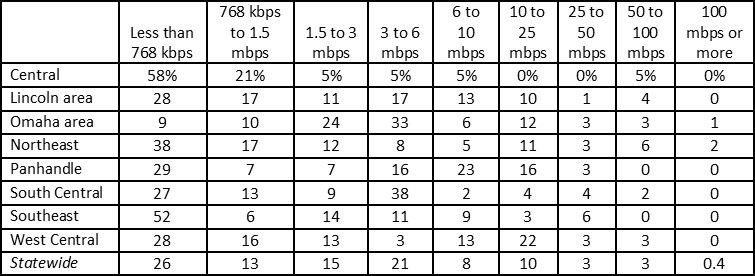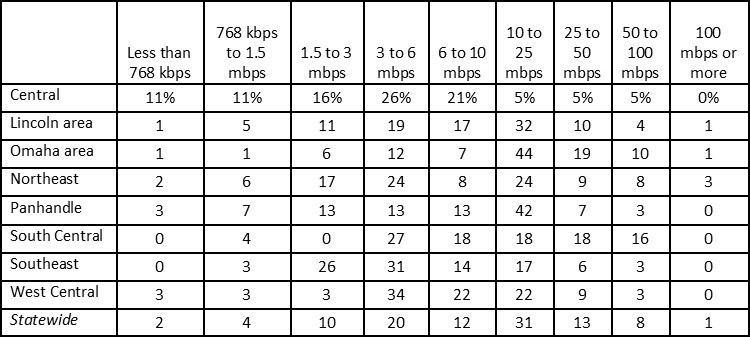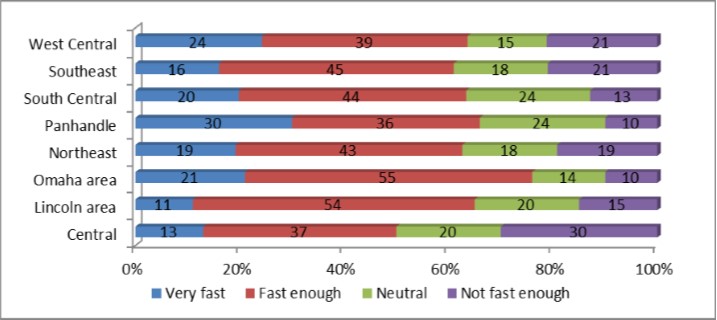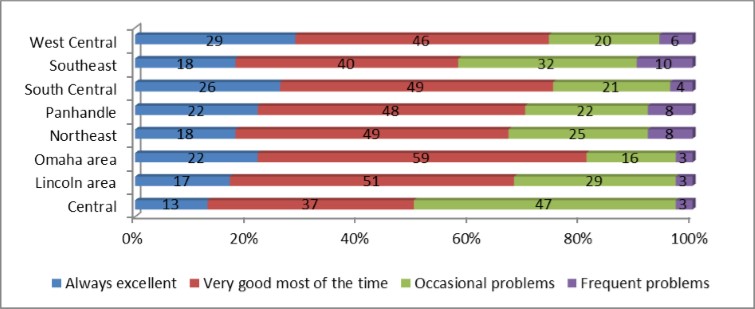Cornhusker Economics October 29, 2014
Technology Use by Businesses in Nebraska: Regional Comparisons
In September 2013, the Nebraska Broadband Initiative partnered with the Strategic Networks Group (SNG) to conduct an email survey of Nebraska businesses on their use of broadband technologies. Responses from over 800 Nebraska businesses show that broadband is being widely used and is benefiting businesses across the state. This paper will take a closer look at the responses by region of the state. For this report, the region boundaries are defined by the Nebraska Economic Development Districts.
How Businesses Connect to the Internet
Businesses across the state connect to the Internet using a variety of technologies. The most common types of connections are cable (29%), DSL (24%) and fiber (20%). However, the type of technology used varies by the region in which the business is located. Businesses located in the Omaha area are more likely than businesses in other regions to connect using cable. Almost one-half (49%) of businesses in the Omaha area use cable to connect to the Internet. Fiber is more prevalent for businesses in both the Panhandle and West Central regions of the state. The dominant technology used by businesses in the Central region is DSL. Satellite connections are more common for businesses in both the South Central and Central regions as compared to businesses in other regions of the state.
The businesses were also asked if they have more than one type of Internet access. Statewide, just over one-third (34%) of the businesses report having more than one type of Internet connection. When breaking down the responses by region, multiple connections are more common for businesses in the Omaha area (42%), the Panhandle (36%) and the Lincoln area (35%). Businesses in the South Central region (23%), the Central region (26%), the Southeast region (27%), Northeast region (29%) and West Central regions (29%) are somewhat less likely to have more than one type of Internet access.

Economic Development Districts in Nebraska

Primary Internet Access Technology by Region
During the survey, businesses had the opportunity to take a live speed test that assessed their actual upload and download speeds. The speed test was provided by the Nebraska Public Service Commission. Not all businesses chose to complete the speed test, but 464 respondents did so and the results were automatically entered into the survey. Statewide, just over one-quarter (26%) of the businesses had upload speeds less than 768 kbps. However, over one-half of Central region businesses (58%) and Southeast region businesses (52%) have upload speeds less than 768 kbps. The proportions of businesses having upload speeds under 1.5 mbps include Central (79%), Southeast (57%), Northeast (55%), Lincoln (44%), West Central (44%), South Central (40%), Panhandle (36%), and Omaha (18.5%).
When assessing the download speeds, only two percent of businesses statewide recorded less than 768 kbps. However, 11 percent of businesses in the Central region had download speeds less than 768 kbps. The proportions of businesses having download speeds under 1.5 mbps include: Central (21%), Panhandle (10%), Northeast (8%), Lincoln (6%), West Central (6%), South Central (4%), Southeast (3%), and Omaha (2%). The Strategic Networks Group has determined that there is a stronger correlation between Internet utilization and upload speeds than with download speeds for businesses.

Upload Speeds by Region

Download Speeds by Region
Businesses' Satisfaction with Internet Service
The businesses were asked their satisfaction with the speed of their Internet service. Overall, most businesses rate their service as very fast (19%) or fast enough (48%). Only 15 percent of businesses statewide say their service is not fast enough. However, these opinions differ by region of the state. Businesses in the Panhandle are more likely than businesses in other regions of the state to say their Internet is very fast (30%). This likely reflects their higher utilization of fiber connections (34% of Panhandle businesses have a fiber connection). Many businesses in the Central region (30%) say their Internet service is not fast enough. This is not surprising given the speed test results and their reliance on DSL service. Statewide speed test results showed DSL connections had slower average upload and download speeds than fixed wireless, T1, cable and fiber connections.

Satisfaction with Internet Speed by Region
Businesses were also asked to rate the reliability of their Internet service. Statewide, over two in ten businesses (21%) rate their service as always excellent. Over one-half of the businesses (52%) rate it as very good most of the time. Only five percent say they have frequent problems with their service and 23 percent report occasional problems. Regional differences are detected in these ratings. Businesses in the West Central (29%) and South Central (26%) regions are more likely than businesses in other regions to say their Internet service reliability is always excellent. Businesses in the Southeast region (10%), the Panhandle (8%) and Northeast region (8%) are more likely than businesses in other regions to report having frequent problems with their reliability. One-half of businesses in the Central region report having frequent or occasional problems and 42 percent of businesses in the Southeast region report frequent or occasional problems.

Satisfaction with Reliability of Internet Service by Region
Many businesses in the state, regardless of what region they are located in, say the Internet was an important consideration in selecting their location. Over one-half of the businesses rated the availability of broadband Internet access as either very essential (38%) or very important (14%) in selecting their location. Furthermore, 64% say broadband is essential for remaining in their current location.
Business Utilization of Broadband Applications
Businesses were then asked if they are currently using 17 different Internet applications in their operations. The majority of businesses in Nebraska are currently utilizing each of the applications listed. Regional differences in utilization are detected for some of these applications. Businesses in the Lincoln and Omaha areas are more likely than businesses in other regions of the state to currently utilize the following applications: a website for their organization, deliver services and content online (e.g. video streaming, digitized products), tele-working (employees work from home), and rich media or service creation (e.g. multimedia content, interactive tools). As an example, 58 percent of businesses in both the Omaha and Lincoln areas are currently using rich media or service creation. In comparison, only 30 percent of businesses in the Central region are using this application.
Businesses in the Central region are less likely than businesses in other regions of the state to use the following applications: deliver services and content online, rich media or service creation, and accessing collaborative tools (e.g. file sharing, shared document editing, wiki pages, Blogs). However, many businesses in that region are planning to use them in the future. For example, only 27 percent of businesses in the Central region are currently delivering services and content online, but 20 percent plan to use it in the future.
Barriers to Using Internet Applications
The businesses were also asked to rate the significance of a number of possible barriers to effectively using broadband in their operations. Most Nebraska businesses rated the following barriers as very or somewhat important: security concerns (76%), privacy concerns (66%), loss of contact with clients (59%), lack of internal expertise (51%) and development/maintenance costs (51%). Some of the barriers are more significant for businesses in some regions as compared to others. Over one-third of businesses in the Southeast region (35%) rate "the available Internet is too slow" as a very important reason for being unable to effectively use broadband applications in their operations. In comparison, only 12 percent of Omaha area businesses cited this reason as a very important barrier. Significant proportions of businesses in the following regions rate this barrier as either very or somewhat important: Southeast region (60%), Panhandle (50%), West Central region (49%), and Central region (47%). Only 29 percent of Omaha area businesses say this is a very or somewhat important barrier to effectively using broadband applications in their operations.
These comparisons highlight regions in the state that face challenges to encouraging technology use by their businesses. In particular, businesses in the Central region have, on average, slower Internet connection speeds. They are also less likely than businesses in other regions to utilize more advanced Internet applications. Opportunities to increase the utilization of broadband applications exist in this region, but many businesses will require faster connection speeds to do so. This survey did not ask about the types of Internet services available to businesses. Many businesses may have access to higher connection speeds but have chosen not to purchase these services that could help them utilize more of these applications.
More information about the Nebraska Broadband Initiative; a summary of the business survey; or the complete report "Nebraska Broadband eSolutions Benchmarking Report: Utilizations and Impacts of Broadband for Nebraska Businesses" may be found at: http://broadband.nebraska.gov/
Broadband Steering Team members include: Gene Hand, Steve Meradith and Cullen Robbins, Nebraska Public Service Commission; Anne Byers, Nebraska information and Technology Commission; Allison Hatch, State of Nebraska Department of Economic Development; Rod Armstrong, AIM Institute; Roger Terry, UNL Ed Media; Jan Jackson Cejka, Jim Keeler, ,Charlotte Narjes and Becky Vogt, UNL Department of Agricultural Economics; and Connie Hancock, UNL Extension-Cheyenne County. The Broadband Mapping and Planning Initiative is funded through a grant to the Nebraska Public Service Commission by the U.S. Department of Commerce's National Telecommunication and Information Administration and aims to increase broadband adoption and utilization. The University of Nebraska is leading the planning efforts. Planning project partners include the University of Nebraska-Lincoln, Nebraska Information Technology Commission, Nebraska Department of Economic Development and AIM Institute.
Becky Vogt, (402) 329-6251
Department of Agricultural Economics
rvogt2@unl.edu
Charlotte Narjes, (402) 472-1724
Department of Agricultural Economics
cnarjes@unl.edu
Roger Terry, (402) 472-0025
Department of Agricultural Leadership, Education and Communication
rterry2@unl.edu
Connie Hancock, (308) 254-4455
Extension Educator
chancock1@unl.edu